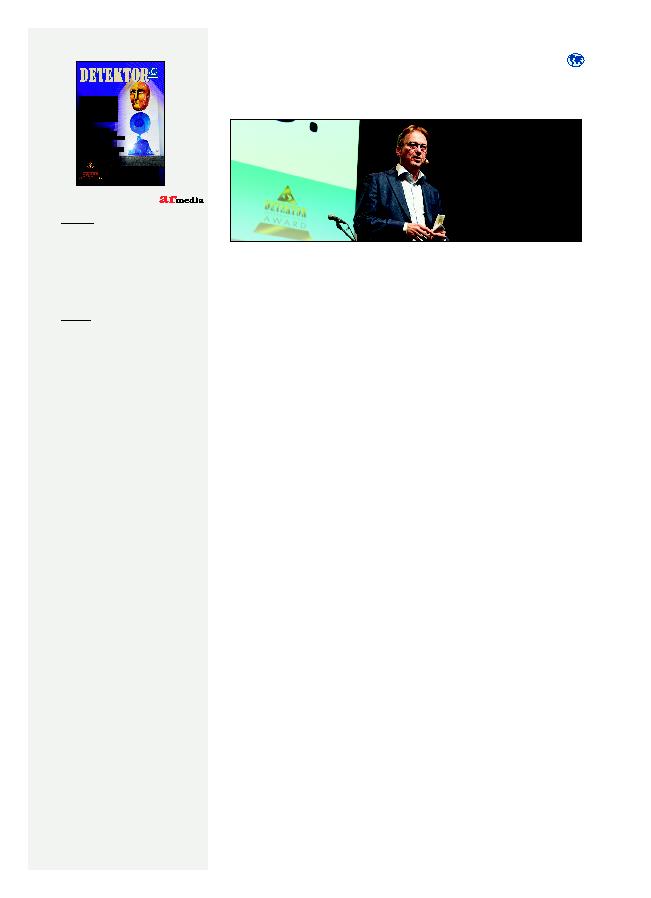
publisher's
comment
WWW.DETEKTOR.COM · THE GLOBAL SECURITY MAGAZINE · PRODUCED BY AR MEDIA INTERNATIONAL AB · NO 1 2025
OF THE YEAR
THE SECURITY PRODUCTS
DETEKTOR INTERNATIONAL AWARD PRESENTS THE TOP 12 PRODUCTS IN 2025
Publisher's comment:
Europe's security industry at risk
when regulation becomes a barrier
The security technology market:
Global physical security market to
surpass 150 billion dollars by 2030
The interview Gerard Figols, I-Pro:
"Cameras will become AI agents"
W
W
W
.
DE
T
E
K
T
OR
.
COM
·
T
HE
GL
OB
A
L
S
E
CU
RIT
Y
MA
G
A
Z
INE
·
P
R
ODU
C
E
D
B
Y
A
R
ME
DIA
INT
E
RNA
T
IONA
L
A
B
·
NO
1
·
20
2
5
SPECIAL EDITORIAL FEATURE:
SPECIAL EDITORIAL FEATURE:
terrorism and cross-border
intrusions propel the market
cloud solutions drive the market
PERIMETER SECURITY
ACCESS CONTROL
Omslag_Det_Int_1_2025.indd 1
Omslag_Det_Int_1_2025.indd 1
2025-10-17 11:19
2025-10-17 11:19
Europe's security industry at risk
when regulation becomes a barrier
T
he European security industry finds itself at a
crossroads, facing both extraordinary oppor-
tunities and profound challenges. Emerging tech-
nologies such as artificial intelligence, biometric
authentication systems, and advanced surveil-
lance solutions promise more effective protection
against crime, cyber attacks, and terrorism. Yet it
is precisely these innovations that risk being sti-
fled by the dense web of regulation taking shape
within the European Union.
Two legislative pillars are particularly signifi-
cant: the General Data Protection Regulation
(GDPR) and the forthcoming AI Act. Both aim
to safeguard individual rights, strengthen privacy,
and foster trust in digital technologies. However,
for the security sector they also impose a heavy
burden. GDPR restricts the use of sensitive
personal data, such as biometric identifiers, to
train and improve AI-based security systems.
Meanwhile, the AI Act classifies many of the
industry's most promising technologies as "high
risk." This designation entails extensive require-
ments for documentation, transparency, risk
assessments, and third-party audits--processes
that slow innovation and place costs on compa-
nies, especially smaller players that may lack the
necessary resources.
This is not merely a matter of economics or
business growth. When European companies are
limited in their ability to develop new security
solutions as quickly as competitors in the United
States or China, the consequences extend to pub-
lic safety itself. Police forces, border agencies, and
defence institutions face restrictions in deploying
AI tools to combat organised crime or terrorism.
Businesses already under constant threat from
cyber attacks risk losing access to the most effec-
tive protective technologies. Ultimately, it is the
citizens who pay the price. Regulations designed
to protect privacy can, in practice, leave society
more vulnerable to real-world threats.
The global comparison is stark. In the United
States, regulation is fragmented and often market-
driven, allowing companies to experiment and
deploy new technologies at a much faster pace.
China goes even further, with state-backed devel-
opment and access to massive data sets enabling
its companies to dominate surveillance technol-
ogy and export it worldwide. Europe, by contrast,
emphasises strict precautionary regulation, but at
the cost of slower innovation cycles and reduced
competitiveness.
In addition to GDPR and the AI Act, other
EU laws shape the sector's landscape. The NIS2
Directive strengthens cyber security obligations
for critical sectors such as energy, transport, and
healthcare, while the CER Directive seeks to pro-
tect critical infrastructure against both physical
and digital threats. These frameworks undoubt-
edly improve resilience, yet they also increase
the regulatory burden and complexity faced by
market actors.
The challenge for the European Union is thus
to strike a delicate balance. On the one hand,
there is a legitimate responsibility to uphold
fundamental rights and ensure that technology
is deployed ethically and lawfully. On the other,
Europe must safeguard its capacity for innovation
and competitiveness in a world where threats are
escalating and where other global powers are far
less hesitant to push boundaries. Failure to find
this balance risks not only a loss of technologi-
cal leadership, but also greater vulnerability for
European societies.
It is a paradox that demands political courage:
acknowledging that an excessive focus on privacy
can, in practice, erode security. Europe's security
industry has the potential to drive both economic
growth and societal resilience--but only if regula-
tion is shaped to enable innovation rather than
suffocate it.
ISSN-1651-3800 published by
Head office:
AR Media International AB
Elektravägen 14 · S-126 30 Hägersten
Sweden
Tel: +46 8 556 306 80
E-mail: info@armedia.se
www.detektor.com
www.armedia.se
Asia Office
Asha Chang
AR Media Marketing Corporation
Address: 3F., No. 197, Xinshih 3rd Road
Sec. 2, Tamsui District (251),New Taipei,
Taiwan
Office phone: +(886-2) 2622 1365,
+(886-2) 2622 1385
Mobile: +(886) 922 116272,
Email: asha@armediaint.com
General Information
· Detektor International is published twice a year.
· No part of this magazine may be reproduced
without prior permission from the publisher.
· Detektor International welcomes manuscripts,
news, releases and photographs, but cannot
be held responsible for loss or damage
incurred in transit or in possession.
· News releases can be sent to
intnews@securityworldmarket.com
Subscriptions
Anette Friberg
+46 8 556 306 80
One-year subscription
Detektor International, 1 year/1 issue *,
printed edition. Price: 15
Publisher
Lennart Alexandrie
lennart.alexandrie@armediaint.com
Editorial Team
Rachel Ward Owens, Markus Lahtinen,
Jonny Sjöberg, Lennart Alexandrie
info@armedia.se
Art Director
Linn A. Maddern
linn.maddern@armedia.se
Advertisements
Deniz Baykal
deniz.baykal@armedia.se
Printing
Stibo, 2025
d e t e k t o r i n t e r n a t i o n a l · 3
Security News Every Day
www.securityworldmarket.com
Lennart Alexandrie, Publisher.
